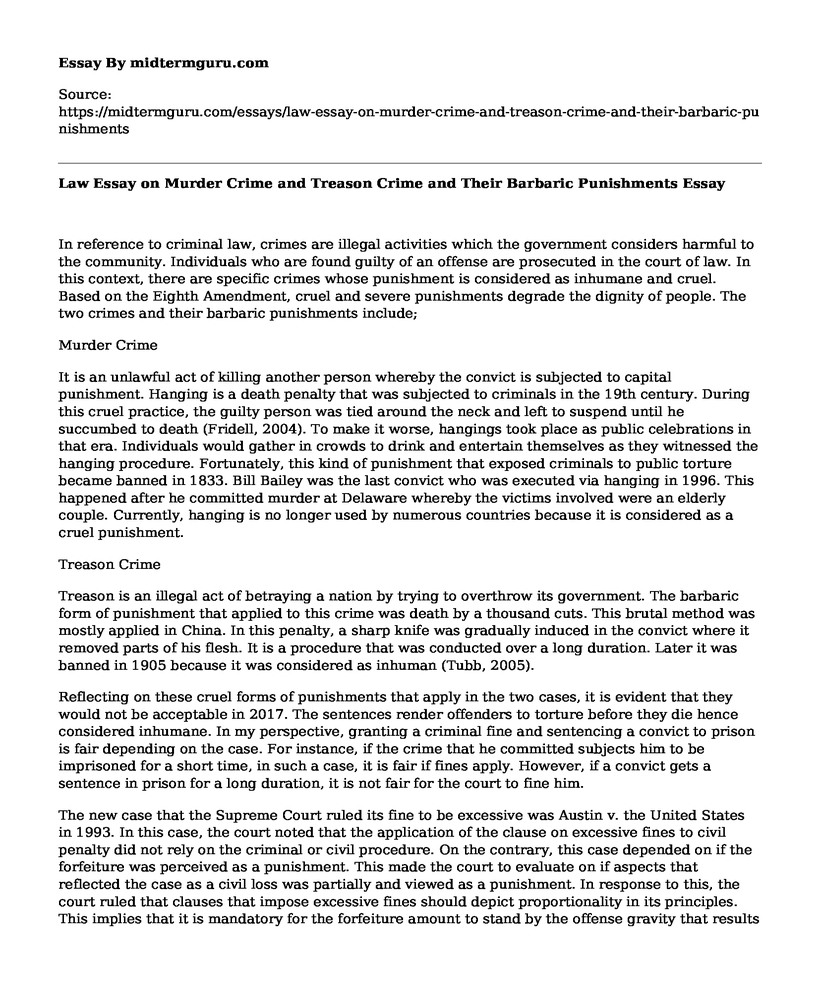In reference to criminal law, crimes are illegal activities which the government considers harmful to the community. Individuals who are found guilty of an offense are prosecuted in the court of law. In this context, there are specific crimes whose punishment is considered as inhumane and cruel. Based on the Eighth Amendment, cruel and severe punishments degrade the dignity of people. The two crimes and their barbaric punishments include;
Murder Crime
It is an unlawful act of killing another person whereby the convict is subjected to capital punishment. Hanging is a death penalty that was subjected to criminals in the 19th century. During this cruel practice, the guilty person was tied around the neck and left to suspend until he succumbed to death (Fridell, 2004). To make it worse, hangings took place as public celebrations in that era. Individuals would gather in crowds to drink and entertain themselves as they witnessed the hanging procedure. Fortunately, this kind of punishment that exposed criminals to public torture became banned in 1833. Bill Bailey was the last convict who was executed via hanging in 1996. This happened after he committed murder at Delaware whereby the victims involved were an elderly couple. Currently, hanging is no longer used by numerous countries because it is considered as a cruel punishment.
Treason Crime
Treason is an illegal act of betraying a nation by trying to overthrow its government. The barbaric form of punishment that applied to this crime was death by a thousand cuts. This brutal method was mostly applied in China. In this penalty, a sharp knife was gradually induced in the convict where it removed parts of his flesh. It is a procedure that was conducted over a long duration. Later it was banned in 1905 because it was considered as inhuman (Tubb, 2005).
Reflecting on these cruel forms of punishments that apply in the two cases, it is evident that they would not be acceptable in 2017. The sentences render offenders to torture before they die hence considered inhumane. In my perspective, granting a criminal fine and sentencing a convict to prison is fair depending on the case. For instance, if the crime that he committed subjects him to be imprisoned for a short time, in such a case, it is fair if fines apply. However, if a convict gets a sentence in prison for a long duration, it is not fair for the court to fine him.
The new case that the Supreme Court ruled its fine to be excessive was Austin v. the United States in 1993. In this case, the court noted that the application of the clause on excessive fines to civil penalty did not rely on the criminal or civil procedure. On the contrary, this case depended on if the forfeiture was perceived as a punishment. This made the court to evaluate on if aspects that reflected the case as a civil loss was partially and viewed as a punishment. In response to this, the court ruled that clauses that impose excessive fines should depict proportionality in its principles. This implies that it is mandatory for the forfeiture amount to stand by the offense gravity that results in punishment. In the past years, this court had no more power over cases that incorporated many fines. According to the court, excessive fines were directly imposed if they were being paid to the government. The Supreme Court still maintains that excessive fines can only be imposed on civil loss cases.
These forms of punishments are cruel and inhumane as they cause pain, suffering, and torture to the person before his death hence are not acceptable in today's era. Therefore it follows that they should be barred.
References
Carter, L. E., Kreitzberg, E., & Howe, S. W. (2012). Understanding capital punishment law. New Providence, NJ: LexisNexis.
David, A. (1980). Famous Supreme Court cases. Minneapolis: Lerner Pub. Co.
Fridell, R. (2004). Capital punishment. New York: Benchmark Books.
Parrish, M. E. (2010). The Supreme Court and capital punishment: Judging death. Washington, D.C: CQ Press.
Tubb, K. O. D. (2005). Freedom from cruel and unusual punishment. Detroit [Mich.: Greenhaven Press/Thomson Gale.
Cite this page
Law Essay on Murder Crime and Treason Crime and Their Barbaric Punishments. (2021, Jun 08). Retrieved from https://midtermguru.com/essays/law-essay-on-murder-crime-and-treason-crime-and-their-barbaric-punishments
If you are the original author of this essay and no longer wish to have it published on the midtermguru.com website, please click below to request its removal:
- Essay on Problem-Solving Courts
- Discussion Post: How Gun Laws Have Changed Since Sandy Hook
- Nature and Extent of Youth Offending - Essay Sample
- Juvenile Delinquency & Adult Crime: Exploring the Link - Essay Sample
- Plato Justices - Essay Sample
- Victimology: A Study of Victims in Criminal Justice Through Time - Essay Sample
- Factory Workers in Industrial Revolution: Poor Wages, No Rights - Essay Sample







